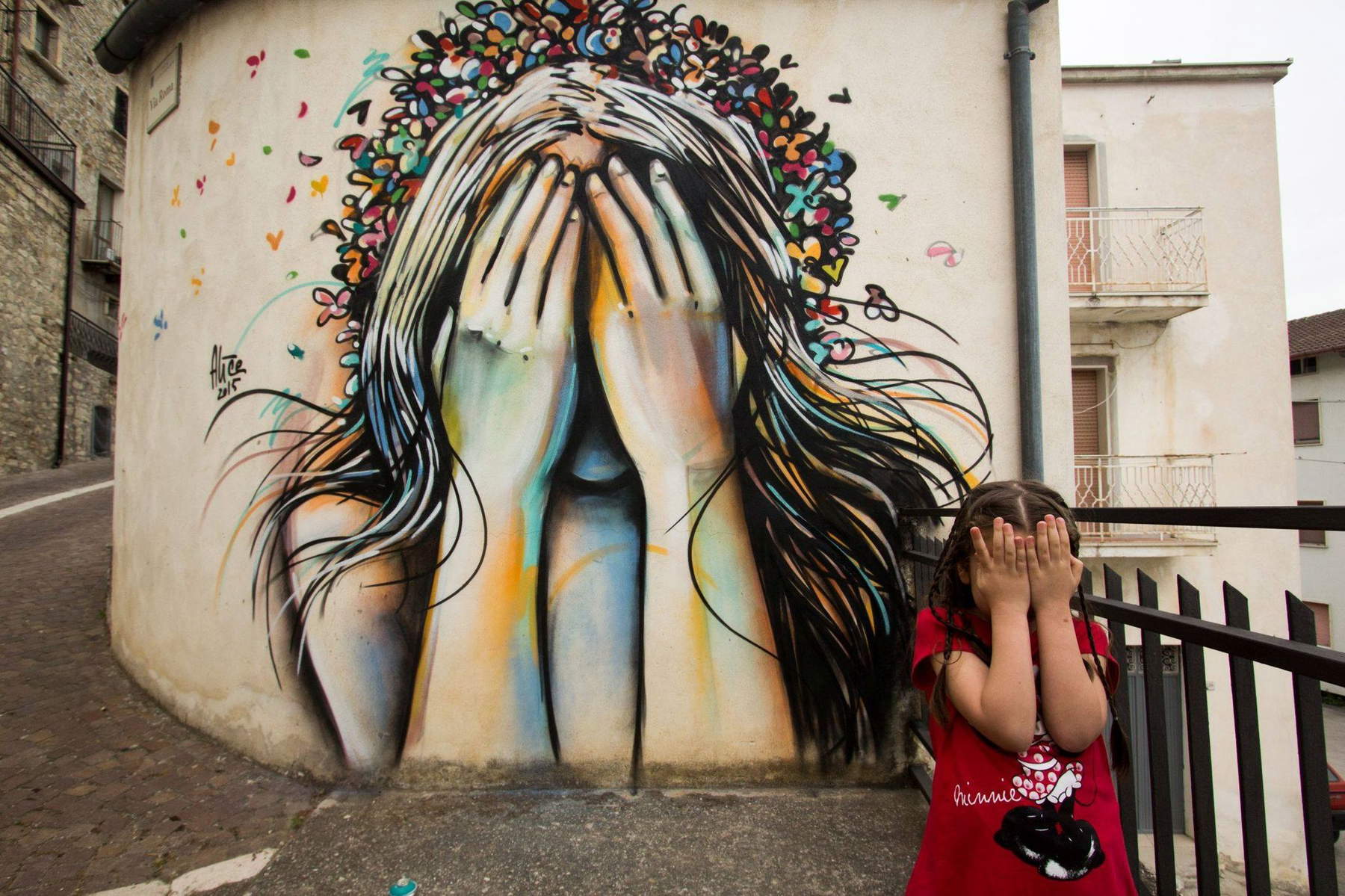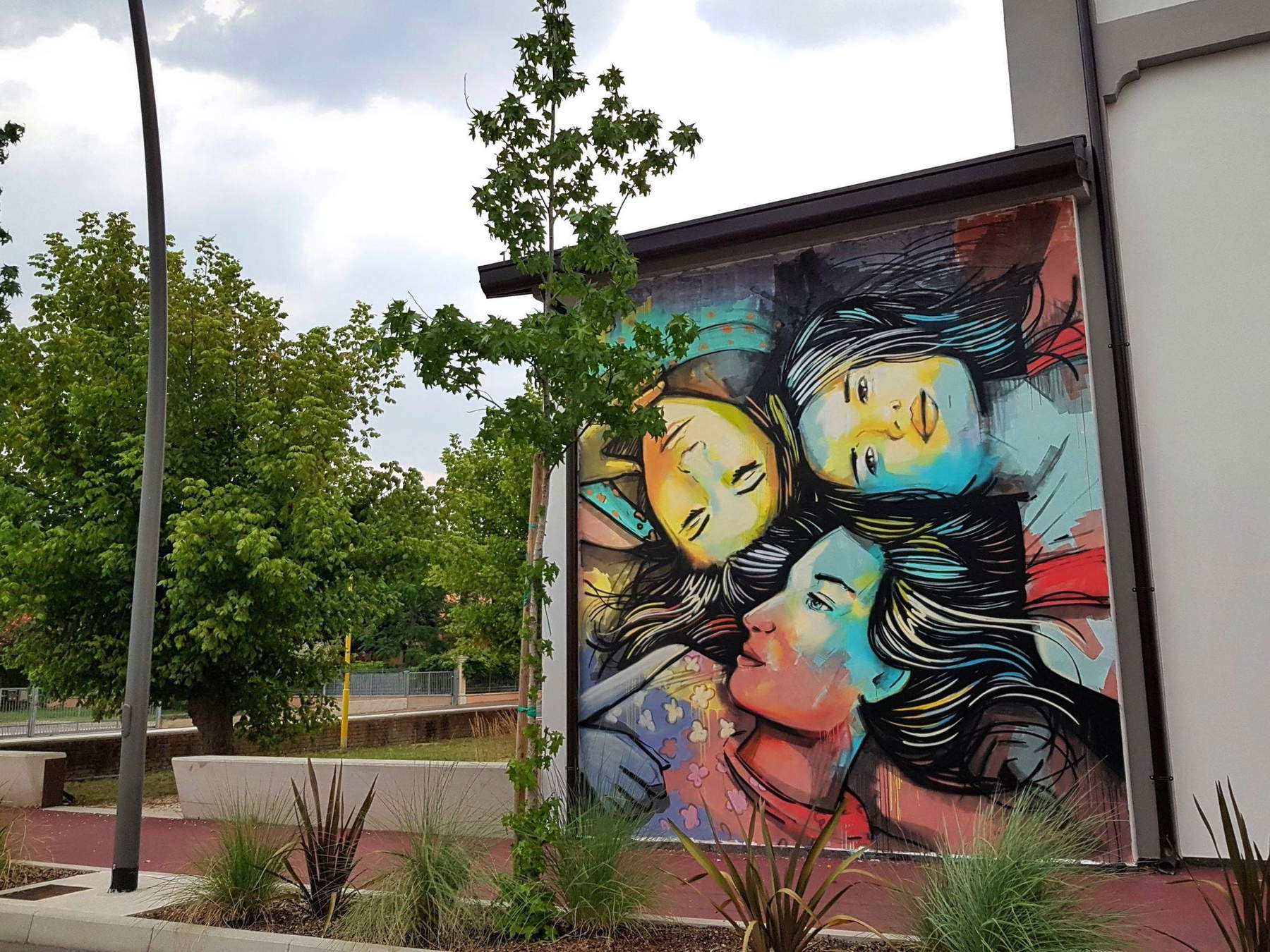Alice Pasquini, aka Alicè (Rome, 1980), is an internationally recognized street artist : her monumental works of urban art are scattered all over the world. The artist is the protagonist of Beyond the Wall: Art and Context, an online workshop as part of the Peggy Guggenheim Collection project, in collaboration with Swatch Art Peace Hotel, entitled Overcoming. Artistic Practices for a New Present. Starting with a reflection on urban transformation and recovery through the study of different techniques and the design of one or more works of public art, the workshop aims to analyze what it means to “make” street art, under what forms street art manifests itself and what has been the evolution of this artistic language from the 1950s to the present. In the meantime, we spoke with Alicè about her art, the main themes she addresses in her works, and what motivated her to paint on the street. The interview is edited by Ilaria Baratta.
 |
| Alice Pasquini |
IB. Re-appropriation of public spaces: it is becoming an increasingly widespread phenomenon to re-evaluate places of degradation that are less frequented by the local community through the creation of large works of street art with the aim of creating places of sharing and sociality especially for young people. Is this then the new present of art?
AP. Well, it has been since the 1970s now. I think it was partly like that before, because of a search that led artists to go outside, beyond the studio. Not to give the classic example of graffiti in caves, I would actually say that already the Impressionists had said “the world is my studio”-I see a connection with all contemporary art research. Currently there is a rapprochement with painting that was now something almost distant, past, at least when I was a student at the Academy of Fine Arts. Art was more video art, action, happenings, and painting was something that seemed almost outdated, apart from the transavantgarde of the 1980s. And instead now for the first time in the history of art and humanity, in all parts of the world, artists are painting larger and larger surfaces. Regarding the social value of public art, yes, it is closely related: clearly the wall is not a canvas, and the city is not a studio, so there is a responsibility and inspiration also comes from the shape of the wall, the color, its history (it is not the same thing to paint in Singapore or Moscow). It is an art that I prefer to call contextual, that is, it comes about for that specific place and that’s it.
Art as an antidote to exclusion and marginalization: do you agree with this definition? Why does street art, compared to traditional art, seem to be better suited for this purpose?
I speak from my own experience. For me, going to the street to paint was a reaction to academism and the idea of art as it was taught at the time, when I was a student. Now I don’t know what the situation is like, however basically with little perspective toward the future and partly distrust and a consideration of art only with a capital A. In this country where art should be the first thing and should also be protected, the many forms of art are considered second-class: I’m talking about illustration, comics (in fact our best illustrators often go abroad, to Paris or other such places, because here there is no room for forms that are not yet perhaps very academic). Things are changing, from the time I started painting in the street to today: I myself am mentioned in the Treccani encyclopedia under the heading of artist, but clearly the moment of breaking with academicism is past, it’s outdated, while I lived through the moment when the phenomenon was exploding all over the world. Certainly there were few people, and especially fewer women, in the world doing it. It was a phenomenon that was intended to break with academicism, but above all it was intended to paint where you wanted, what you wanted, when you wanted. This kind of reappropriation by artists, as is often the case in art history, comes from the technical invention, in this case the spray, which allows you to do things very quickly and very large. It completely changes the approach. As far as I am concerned, what made me paint in the street is the search for an art in contact with people, a real art, the idea of an intimate representation in a public space, working on vulnerable surfaces rather than on white walls and on walls with already a story (a writing, a sign), on rusty doors, working with abandonment to give it back to the city instead... is a whole other form. Now street art has become mainstream (think of superstars, auctions, galleries); this phenomenon has generated for the first time a parallel market, which challenges the rules of the art market, but it was mainly people, citizens, who became passionate about this art form and became its promoters through social media and the Internet. Now we talk more and more about redevelopment, using the term street art, however there is still in my opinion a lot of confusion about what is freedom of expression, public art.
 |
| A work by Alice Pasquini |
 |
| A work by Alice Pasquini |
 |
| A work by Alice Pasquini |
What is the difference between street art and public art in your opinion?
Apart from the term street art, which I don’t like; it was invented because a practice had to be made acceptable, as if there was a difference... Actually street art doesn’t mean anything at all to me. When I started, it was called graffiti, after which there was a moment in the 2000s when, having passed the generation of Basquiat and Haring, we came to the post-graffiti period, with the development of posters, stencils and all those forms that were no longer just lettering; so a figuration that seemed outdated and instead was reborn also found a place. For me this art is not the outlet of an artist and his narcissism, but it becomes interaction with the public space, reminding us that a wall is a wall, it is not a canvas, and that there are people living there. Today, when for more than fifteen years now it has become my job and I get called all over the world to make big walls, keeping the initial romanticism means working on more social experiences, so with immigrants who come here, but also with Italians who have emigrated abroad, or inside a prison or on a real border wall or organizing a festival in an abandoned village in Molise. Let’s say that for me this art, now in fashion, serves to turn on a light in some situations. And on the initial reason for breaking--clearly, like all art forms, there is the ebb, right?
So a street artist’s goal is always to express his or her position to the world through art?
I don’t think so, what brings artists to work in a public space is a personal motive that changes. I speak for myself, not for all street artists in the world. My goal was and is to make art in contact with real people and also to bring in a feminine vision, because often the representation of women in the urban scene in general is used and proposed by men. At the risk of being trivial, I wanted to talk about human feelings and things that actually bind us: traveling all over the world, in many many countries, however, I realized how much more things unite us than things divide us. It is a contemporary art that is often dominated by cynicism and cynical language (where cynical means to be critical and therefore ... more attractive), for me instead in the cities we need something quite different.
Speaking of your personal art, what themes do you mainly deal with? Many of Your works depict women: is this a choice related to a kind of solidarity with the female world or linked to other reasons?
All my art is about human feelings and relationships between people, as I said, in the gap of representing something intimate and personal in a public space. A scene that you can identify with out of humanity, as is often the case with the viewer, which is an amazing thing. I get emails from people who identify with that feeling. As for women, it makes me smile that I, who am a woman, am asked why I paint women, when all painters in the history of art have always painted women. Maybe it is strange because there is a lack of narrative from a female point of view? Who knows.
Which of your works are you particularly fond of? Or for which you feel particularly proud?
In my recently completed monograph book I counted at least a thousand walls, so I really lose count now. For me what matters in this art is the moment in which it is made because unlike art that is produced alone in the studio, this art evolves in contact with people and the history of the neighborhood. And it continues to evolve even when an artist leaves. This kind of practice is always connected to reality, I believe.
In conclusion, what are your future plans?
I paint in so many places. By a series of coincidences then a girl saw me on television and invited me to a very small and remote village in Molise, without realizing that she was writing to me from my grandfather’s village. By that incredible coincidence I went back there and found it completely abandoned. Molise is a land symbolic of forgotten Italy, and I began to paint scenes of the country of yesteryear on the doors of abandoned houses. Tourists started coming back. From this idea we thought that maybe art could save this country and be a symbol of so many countries that there are in Italy, like in Portugal, in Spain, just to name a few. And so it has been: for more than six years we have brought more than thirty international artists to work there; not only walls, but also installations, interventions, and now the village is being reborn thanks to tourists, thanks to foreigners who have bought houses, thanks to the solidarity that has formed around an idea of resistance based on art, so the whole village has rolled up its sleeves and decided not to disappear by betting on artists.
Warning: the translation into English of the original Italian article was created using automatic tools. We undertake to review all articles, but we do not guarantee the total absence of inaccuracies in the translation due to the program. You can find the original by clicking on the ITA button. If you find any mistake,please contact us.